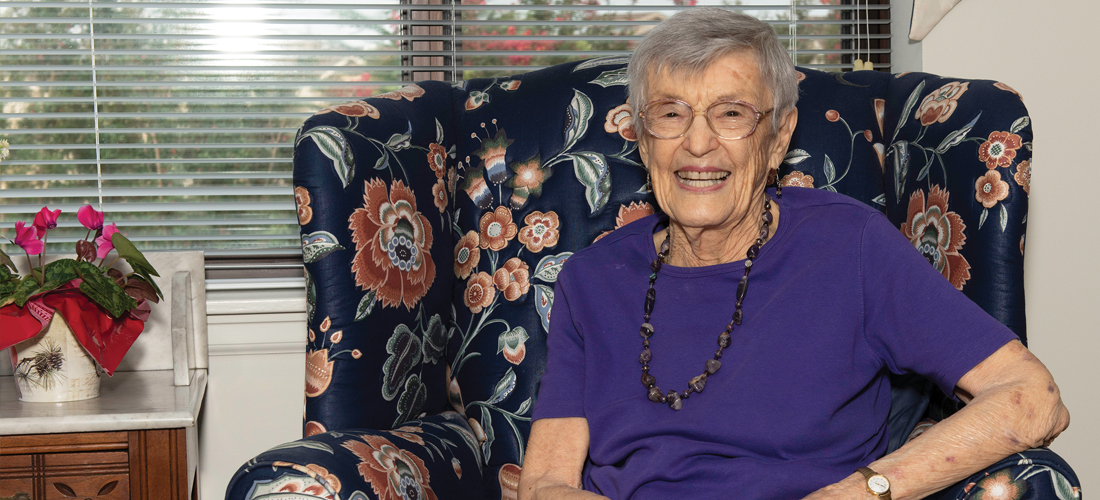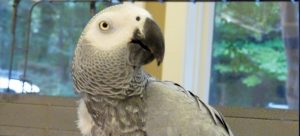
Our Gal Friday
After 70-plus years, former local reporter Eleanor Dare Kennedy feels the pull of printer’s ink
By Billy Eye
“Fifty percent of people won’t vote, and fifty percent don’t read newspapers. I hope it’s the same fifty percent.”
— Gore Vidal
I spent a wonderful afternoon at Friends Homes West visiting with Eleanor Dare Kennedy who spent three decades writing for the Greensboro Record and the Greensboro Daily News. Hired on full time in 1945 by Anne Cantrell White, she was an integral part of the team that made up the women’s section of the newspaper.
“We wrote the weddings, we wrote parties,” Kennedy told me. “The paper was full of bridal showers, things of that sort. Gradually I morphed into doing more features.”
The first real story she filed was about the Art Deco bus station built to replace the original depot, which had been in the basement of the King Cotton Hotel. “I wrote all there was to say about it, which was four paragraphs. My city editor said, ‘This is not long enough’ so he showed me how to, what he called, ‘needle’ a story. Saying the same thing in three different ways to make it a little bit longer.”
Working on what was called the “day side” she could submit a story at 3:30 p.m. and, “It would be on your front porch that afternoon.” The newsroom Kennedy describes is reminiscent of those depicted in the movies; cigarette smoke clouding the air as news and sports writers in a central bullpen generated a constant cacophony of clacking keys. The women’s department was located in a smaller adjacent room, “There was no air conditioning; they had big fans that blew our papers all over the room.”
After a reporter finished an article, they’d stick it on what was called a “copy hook” on their desk where, Kennedy explains. “Copy boys came and picked that up, then it went to the City Editor [who] read through it. If he found an error, he challenged you.” Next stop was the linotype operators, who typed stories in “hot-type” machines, which cast lead blocks of type that would be used on a press to print the paper. “They were smart, knew the city, they knew the grammar, knew spelling, everything. If they found an error they’d come back, challenge you. When they got through, it went to the proofreader. Likewise.” There were, in her opinion, fewer errors in the paper in those days.
What was Kennedy’s favorite opening paragraph? “It was pretty nervy. My lead said: ‘Two dozen North Carolina women put on their fur coats and diamond earrings and came to Greensboro yesterday to talk about poverty.’”
As for working alongside legendary society columnist Martha Long (who died in 2016), “She and I became very close friends. She was the best editor I ever had; she brought out my best work. Martha was a very good creative writer.” Multitalented, Long not only wrote eye-catching headlines she actually laid out the Women’s section herself. And she never hesitated to do what needed to be done, no matter the hour: “She very graciously would respond at 1 a.m. and go back downtown to the layout department to correct a mistake or whatever.”
Kennedy wasn’t confined to the women’s section. She also covered hard news stories. “I would go to Federal Court in the morning. If there was a story worth reporting, when they adjourned for lunch, I would walk back to the office on Davie Street, write my story, go back to the courthouse when they reconvened at 2, leave say at 3:30, go back and update my story and it would be on your front porch that afternoon.”
Once while digging through files at the Federal Building, “I found the lawsuit filed by Kenneth Lee to be admitted to the law school at the University of North Carolina. That was a scoop,” Kennedy remembers. Word had not yet gotten out that the African-American student was attempting to break the color barrier at UNC-Chapel Hill, she explains. “I wrote that story but I was never told to pursue it. Nowadays it would have been followed up.” Future Supreme Court jurist Thurgood Marshall represented Lee, who successfully enrolled at Chapel Hill in 1951, then went on to be a prominent civil rights lawyer in Greensboro.
In 1968 Judge Elreta Alexander became the first African-American woman ever elected district court judge. Kennedy was first to interview her, “She was good copy! I remember she quoted Esther from the Bible. She told me, ‘And who knoweth whether thou art come to the kingdom for such a time as this?’”
Kennedy was particularly fond of fellow Greensboro Record scribe Anne White. “Very eccentric but she was a wonderful person. She was covering the golf tournament out at Sedgefield and her doctor had told her to take a nap every afternoon. So out there at the golf tournament she’d just lie down on one of the greens and take her nap.”
When Eleanor Kennedy served for a year as president of the North Carolina Press Women, “This one lady, who was editor of a small town newspaper, asked Anne, who was very liberal, ‘Anne, what are you going to do when a black girl comes up here and wants to announce her engagement?’ Anne said, ‘Do what we’ve been doing, just get the information, write it up, and put it in the paper.’”
After Anne White passed away it was stipulated there would be no service of any kind but, says Kennedy, “Martha Long led the pack and all of us in Anne’s old department decided we would have a memorial service for her in the chapel at First Presbyterian Church. Rich Preyer was the facilitator, and we all just told stories about Anne.” Eleanor’s husband Sol donated the money for a plaque for the church’s columbarium.
“I liked the paper better when the Jeffress family owned it.” Kennedy retired in 1975 after the Record and Daily News were sold to Landmark Communications, based in Norfolk, Virginia. “It wasn’t all bad. We had a managing editor I thought was great but, I don’t know, it got to where it was changing and it wasn’t that much fun anymore.”
Eleanor Dare Kennedy reads the newspaper every day, printer’s ink still coursing through her veins, “For example, they just finished doing restoration on the Julian Price home, Hillside. I would read those stories and say, ‘If I was still working, that would be my job.’” OH
Billy Eye plans to once again participate in the New Garden Friends Cemetery tour on Halloween night conducted by Max Carter, where famous folks from Greensboro history come alive, an event that gets more popular each year. See you there!





